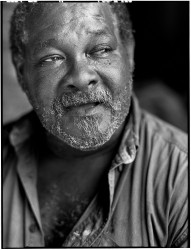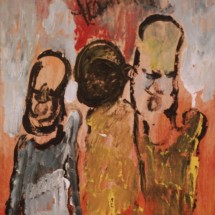Purvis Young (American, 1943–2010)

Photo by David Raccuglia
Young was born in the Liberty City neighborhood of Miami, Florida, and was introduced to drawing by his uncle but gave it up at a young age. He never attended high school and as a teenager he served time in a state penitentiary for breaking and entering. It was in prison that he regained his interest in art and began drawing and studying art in books. There he found inspiration from such artists as Rembrandt, El Greco, Van Gogh, Gauguin, and Picasso among others. After his release from prison, he produced thousands of small drawings, which he kept in shopping carts and later glued into discarded books and magazines that he found in the streets. He continued to create art for the rest of his life often painting on found material as diverse as cardboard, printed book pages, old carpeting, and other detritus. He lived most of his life in what came to be known as Goodbread Alley in Overtown, a section of Miami that was once home to a thriving community of Jamaican immigrants operating bakeries, but which was ravaged by construction of an interstate highway through it in the 1960s. He painted what he saw around him or, simply put by the artist, “What’s on my mind, I paint.” He worked right up until his death caused by cardiac arrest at age sixty-seven.
Young’s work—with its calligraphic lines, crowds of people, frenzied bursts of color and repeated symbols, a personal iconography of horses denoting freedom, angels denoting good people, and round, blue shapes denoting the all-seeing eyes of the establishment—often reflects the cacophony of urban strife. In the painting on view here, three approaching figures seem to lean into one another like a posse of friends, perhaps referring to the brotherly aspects of gang culture.
- Boyz in the ‘Hood ca. 1999

